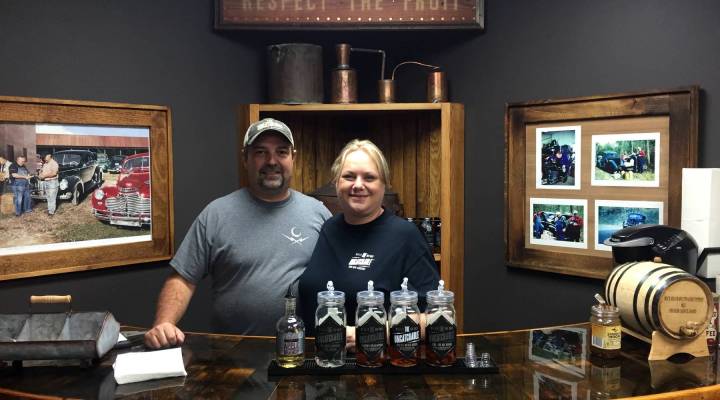
Moonshine enters the mainstream

Brian Call is a seventh-generation distiller. He makes his moonshine, legally, in a warehouse in Wilkesboro, North Carolina, that’s open to the public. A family recipe of moonshine starter fizzes in huge wooden vats. They look like 1,000-gallon hot tubs.
In the past decade, the number of moonshine brands and flavors has grown rapidly. Nationwide, the amount of shine sold is about 16 times what it was a decade ago.
“We got corn meal, barley malt, cracked wheat and a little bit of sugar,” Call said. It’s the same recipe his dad used. He was a bootlegger and made hooch in the woods. “You know, there weren’t a lot of jobs around here in Wilkes County,” Call said.
His dad’s story is as important as the recipe. And that’s true for a lot of legal moonshine producers, for whom marketing their product can get personal.
“The packaging and selling of moonshine really depends upon a selling of a narrative,” said author Matt Bondurant. He wrote “The Wettest County in the World,” a book about his own family’s moonshining past. “A rebellious outlaw sort, you know, distinctly Southern sort of figure.”
Bondurant said that narrative is especially important because moonshine is not likely to impress you when you first taste it.
“What you’ve got, you know, it’s just an extremely high-alcohol-content corn whiskey with a very sort of flat flavor profile, smells just like rotten corn and it will burn you all the way down,” he said. “I mean, there’s not a whole lot going for it.”
You see it lined up on store shelves, often in old-timey square Mason jars or jugs with little handles and labels printed with images of ramshackle homesteads. On the Call Family label, the patriarch’s face looks back at you.
Call’s wife, Laura, takes it a step further — she tells his story during moonshine tastings.
“They love having a family member give them a tour and talk about it,” she said. She’s hung up her father-in-law’s overalls by the entrance and parked the handsome cars he once hauled moonshine in at the back of the store.
“To see the actual moonshine cars is very thrilling for people,” she said. “Because, you know, moonshine, even when people still sip the moonshine, it’s almost like we’re-doing-something-we-shouldn’t-be-doing type thing.”
As the moonshine market matures, some brands have corporate backing and celebrity sponsors. Laura Call said what her distillery has is a real story of humble family members that sold moonshine to make ends meet.
This story was first heard in the podcast “Gravy” from the Southern Foodways Alliance.
There’s a lot happening in the world. Through it all, Marketplace is here for you.
You rely on Marketplace to break down the world’s events and tell you how it affects you in a fact-based, approachable way. We rely on your financial support to keep making that possible.
Your donation today powers the independent journalism that you rely on. For just $5/month, you can help sustain Marketplace so we can keep reporting on the things that matter to you.


















